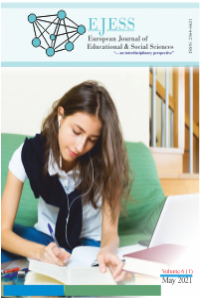Analyzing User Comments on Covid-19 Pandemic with Word2Vec Technique
Analyzing User Comments on Covid-19 Pandemic with Word2Vec Technique
Word Embedding, Word2Vec, NLP, Covid-19,
___
- Abd-Alrazaq, A., Alhuwail, D., Househ, M., Hamdi, M., & Shah, Z. (2020). Top concerns of tweeters during the COVID-19 pandemic: infoveillance study. Journal of Medical Internet Research, 22(4).
- Aggarwal, C., & Zhai, C. (2013). Mining text data. Dasri, Y. B., Barde, B. V., Shivajirao, N. P., & Bainwad, M. A. (2017). Text mining framework, methods and techniques. IOSR Journal of Computer Engineering, 19(4), 19-22.
- Khalid, S., Khalil, T., & Nasreen, S. (2014). A survey of feature selection and feature extraction techniques in machine learning. Proceedings of 2014 Science and Information Conference, SAI 2014. Li, Y., & Yang, T. (2018). Word embedding for understanding natural language: a survey. Guide to big data applications (s. 83-104). içinde Springer International Publishing.
- Mikolov, T., Grave, E., Bojanowski, P., Puhrsch, C., & Joulin, A. (2018). Advances in pre-training distributed word representations. LREC 2018 - 11th International Conference on Language Resources and Evaluation. Miyazaki, Japan.
- Mikolov, T., Kai, C., Corrado, G., & Dean, J. (2013). Efficient estimation of word representations in vector space. 1st International Conference on Learning Representations, ICLR 2013 - Workshop Track Proceedings.
- Mikolov, T., Le, Q. V., & Sutskever, I. (2013). Exploiting similarities among languages for machine translation. arXive:1309.4168.
- Naili, M., Habacha, A., & Ghezala, H. B. (2017). Comparative study of word embedding methods in topic segmentation. Procedia Computer Science, 112, 340-349.
- Tripathy, A., Agrawal, A., & Rath, S. (2016). Classification of sentiment reviews using n-gram machine learning approach. Expert Systems with Applications, 57(October 2017), 117-126.
- Abd-Alrazaq, A., Alhuwail, D., Househ, M., Hamdi, M., & Shah, Z. (2020). Top concerns of tweeters during the COVID-19 pandemic: infoveillance study. Journal of Medical Internet Research, 22(4).
- Aggarwal, C., & Zhai, C. (2013). Mining text data.
- Dasri, Y. B., Barde, B. V., Shivajirao, N. P., & Bainwad, M. A. (2017). Text mining framework, methods and techniques. IOSR Journal of Computer Engineering, 19(4), 19-22.
- Khalid, S., Khalil, T., & Nasreen, S. (2014). A survey of feature selection and feature extraction techniques in machine learning. Proceedings of 2014 Science and Information Conference, SAI 2014.
- Li, Y., & Yang, T. (2018). Word embedding for understanding natural language: a survey. Guide to big data applications (s. 83-104). içinde Springer International Publishing.
- Mikolov, T., Grave, E., Bojanowski, P., Puhrsch, C., & Joulin, A. (2018). Advances in pre-training distributed word representations. LREC 2018 - 11th International Conference on Language Resources and Evaluation. Miyazaki, Japan.
- Mikolov, T., Kai, C., Corrado, G., & Dean, J. (2013). Efficient estimation of word representations in vector space. 1st International Conference on Learning Representations, ICLR 2013 - Workshop Track Proceedings.
- Mikolov, T., Le, Q. V., & Sutskever, I. (2013). Exploiting similarities among languages for machine translation. arXive:1309.4168. Naili, M., Habacha, A., & Ghezala, H. B. (2017). Comparative study of word embedding methods in topic segmentation. Procedia Computer Science, 112, 340-349.
- Tripathy, A., Agrawal, A., & Rath, S. (2016). Classification of sentiment reviews using n-gram machine learning approach. Expert Systems with Applications, 57(October 2017), 117-126.
- Wiederhold, B. K. (2020). Using social media to our advantage: alleviating anxiety during a pandemic. Cyberpsychology, Behavior and Social Networking, 23(4).
- Yayın Aralığı: Yılda 2 Sayı
- Başlangıç: 2016
- Yayıncı: Ali KORKUT
Analyzing User Comments on Covid-19 Pandemic with Word2Vec Technique
Nimet AKSOY, Özlem TÜLEK, Özlem AYDIN, Erol ÖZÇEKİÇ
Kadınlara Yönelik Siber Zorbalık Durumları ve Önlem Çalışmaları
The Impact of Service Providers on Ensuring Service Quality and Customer Satisfaction
Oluwatobiloba Solomon ADEBAYO, Mba Okechukwu JOSHUA
Service Quality Assessment in University Libraries: The Case of Cankiri Karatekin University
Ebeveyn Tutumlarının Çocukların Yetenek ve Becerilerine Etkisi
Mehmet Necati CİZRELİOĞULLARI, Rukiye KİLİLİ
An Investigation to Improve Reading Skills through Newspapers among Intermediate Students
Muhammad Safdar BHATTİ, Rafia MUKHTAR
Uluslararası İşletmecilikte Finansal Risklerin Stratejik Yönetimi
Fatma YEŞİLKUŞ, Onur Başar ÖZBOZKURT
Maslow’un İhtiyaçlar Hiyerarşisi Kendini Gerçekleştirme Basamağında Gizil Yetenekler
Pozitif Gençlik Gelişimi El Kitabı: Küresel Bağlamlardan Güncel Araştırma, Politika ve Uygulamalar
